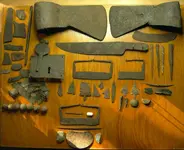Muddyhandz
Bronze Member
- Joined
- Jul 1, 2012
- Messages
- 1,226
- Reaction score
- 1,958
- Golden Thread
- 0
- Location
- In da bush
- Detector(s) used
- Fisher's 1266X, 1270X & 1280X
- Primary Interest:
- All Treasure Hunting
Not just the sharpest but also my 3 best finds for the year, even though I found gold rings, lots of silver, old coins, relics, etc.
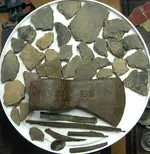
#3. Was this little belt axe that I found in the remote wilderness (on a major water route) behind a very small camping area and was an isolated find.
The camp was more popular in prehistoric times and the only signals were a few iron trim bits, flattened musket ball, piece of thin kettle scrap, ferrous awl (broken tip) and a flat button.
The prehistoric pottery was excavated below the iron trim bits, as I felt something deeper in the sugary soil. I widened the hole to get all the pieces out.
Possibly all from the same pot.
Anyway, here's the axe.....
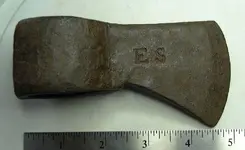
I haven't researched it at all but the first thing that comes to mind is the maker Edward Sorbey. It probably dates from the mid to late 18th century.
Top
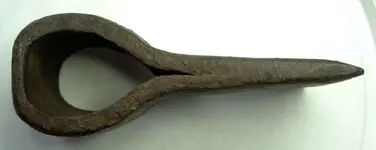
Blade is still good enough to chop wood!
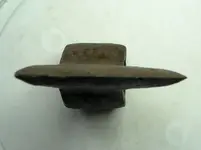
Back
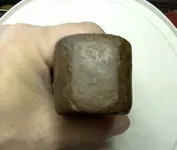
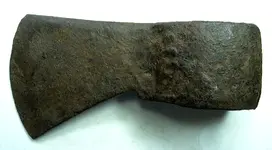
The reverse has much smaller cut marks than what I normally see on axes.
Artifacts will help answer questions and I have several complete or broken axes that have many deep cut marks on them, revealing an answer to a popular question......
How did the Native people cut metal out of kettle scrap and barrel hoops?
IMO, they used a chisel-like implement (edge made from filing) and hammered on objects like axes which served as an anvil.
These much smaller cut marks (pictured above) were possibly from finer work like on silver or even cutting something like leather with a sharp blade.
It's a luxury to have such nice soil conditions to see fine details on ferrous artifacts!
#2. I like this even more than the axe as it was made (most likely) by the Northern Cree and comes from a very early site based on all that had been found there.
I had completely hammered this remote site but chose to rework it due to another location coming up short.
Four hours of bushwhacking with nothing but a few really small iron trim bits, and a sewing needle, I finally got a blast of a signal behind a tree that was easily missed due to the angle.
The signal was long like a muskrat spear but thinner in width so I didn't know what to expect.
Yes, my old VLF provides me with more audio information than any digital readout could ever!

I was pretty happy when this wickedly sharp spear came to light! It could have been used on mammals but given the area it was found at, I feel it was used for sturgeon.
The style reminds me of a harpoon you would find further north and made from bone.
The tip is quite fluted......

A dark shot, showing the depth of the fluting......

Tail
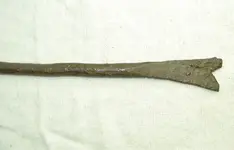
Tail reverse showing that it is split.....
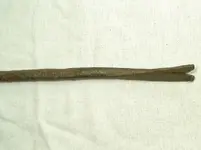
This angle shows how the tail had been hammered thin.
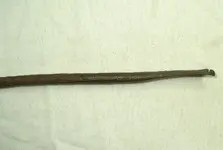
Tip (non-fluted side) and slightly elevated.
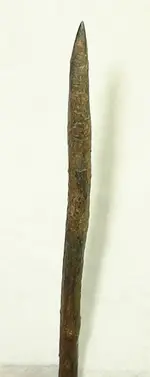
Touch my finger on the tip and I instantly hear that famous voice from Forged in Fire...."It will kill."
#1. Is the sharpest and oldest find of the year.....

A prehistoric copper awl from the Copper Culture. Probably nothing special to you Great Lakes residents but quite scarce this far west.
It was found on a small, elevated oak bluff situated in a major flood zone, near the Red River at it's northern end.
I had found a few historic items there as well, including this fish hook.... http://www.treasurenet.com/forums/fur-trade-artifacts/301722-rolled-copper-hair-tubes-not-always.html(see post)
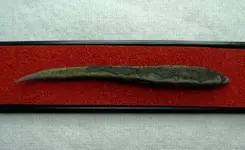
I'm only showing two out of the four sides it has and I could easily draw blood from my finger touching it's sharp tip!
Well, that's awl folks!
All ferrous artifacts were very lightly cleaned, allowed to slowly dry for weeks and coated with microcrystalline conservator's wax.
The copper awl was soaked in distilled water for several days, turning each side.
Thanks for looking!

#3. Was this little belt axe that I found in the remote wilderness (on a major water route) behind a very small camping area and was an isolated find.
The camp was more popular in prehistoric times and the only signals were a few iron trim bits, flattened musket ball, piece of thin kettle scrap, ferrous awl (broken tip) and a flat button.
The prehistoric pottery was excavated below the iron trim bits, as I felt something deeper in the sugary soil. I widened the hole to get all the pieces out.
Possibly all from the same pot.
Anyway, here's the axe.....

I haven't researched it at all but the first thing that comes to mind is the maker Edward Sorbey. It probably dates from the mid to late 18th century.
Top

Blade is still good enough to chop wood!

Back


The reverse has much smaller cut marks than what I normally see on axes.
Artifacts will help answer questions and I have several complete or broken axes that have many deep cut marks on them, revealing an answer to a popular question......
How did the Native people cut metal out of kettle scrap and barrel hoops?
IMO, they used a chisel-like implement (edge made from filing) and hammered on objects like axes which served as an anvil.
These much smaller cut marks (pictured above) were possibly from finer work like on silver or even cutting something like leather with a sharp blade.
It's a luxury to have such nice soil conditions to see fine details on ferrous artifacts!
#2. I like this even more than the axe as it was made (most likely) by the Northern Cree and comes from a very early site based on all that had been found there.
I had completely hammered this remote site but chose to rework it due to another location coming up short.
Four hours of bushwhacking with nothing but a few really small iron trim bits, and a sewing needle, I finally got a blast of a signal behind a tree that was easily missed due to the angle.
The signal was long like a muskrat spear but thinner in width so I didn't know what to expect.
Yes, my old VLF provides me with more audio information than any digital readout could ever!

I was pretty happy when this wickedly sharp spear came to light! It could have been used on mammals but given the area it was found at, I feel it was used for sturgeon.
The style reminds me of a harpoon you would find further north and made from bone.
The tip is quite fluted......

A dark shot, showing the depth of the fluting......

Tail

Tail reverse showing that it is split.....

This angle shows how the tail had been hammered thin.

Tip (non-fluted side) and slightly elevated.

Touch my finger on the tip and I instantly hear that famous voice from Forged in Fire...."It will kill."
#1. Is the sharpest and oldest find of the year.....

A prehistoric copper awl from the Copper Culture. Probably nothing special to you Great Lakes residents but quite scarce this far west.
It was found on a small, elevated oak bluff situated in a major flood zone, near the Red River at it's northern end.
I had found a few historic items there as well, including this fish hook.... http://www.treasurenet.com/forums/fur-trade-artifacts/301722-rolled-copper-hair-tubes-not-always.html(see post)

I'm only showing two out of the four sides it has and I could easily draw blood from my finger touching it's sharp tip!
Well, that's awl folks!

All ferrous artifacts were very lightly cleaned, allowed to slowly dry for weeks and coated with microcrystalline conservator's wax.
The copper awl was soaked in distilled water for several days, turning each side.
Thanks for looking!
Amazon Forum Fav 👍
Upvote
0



